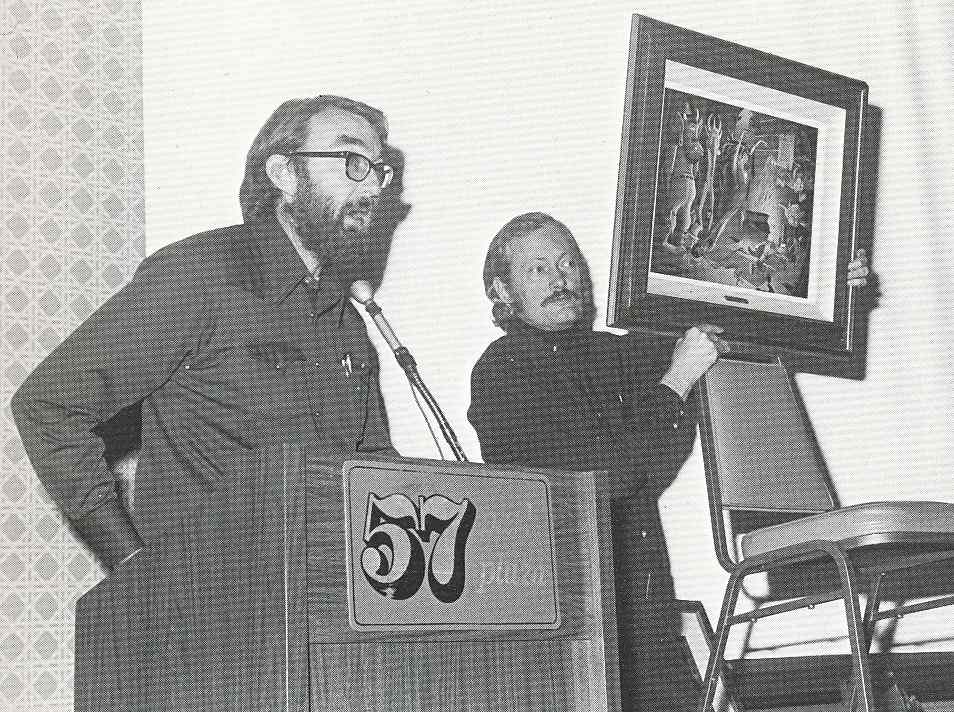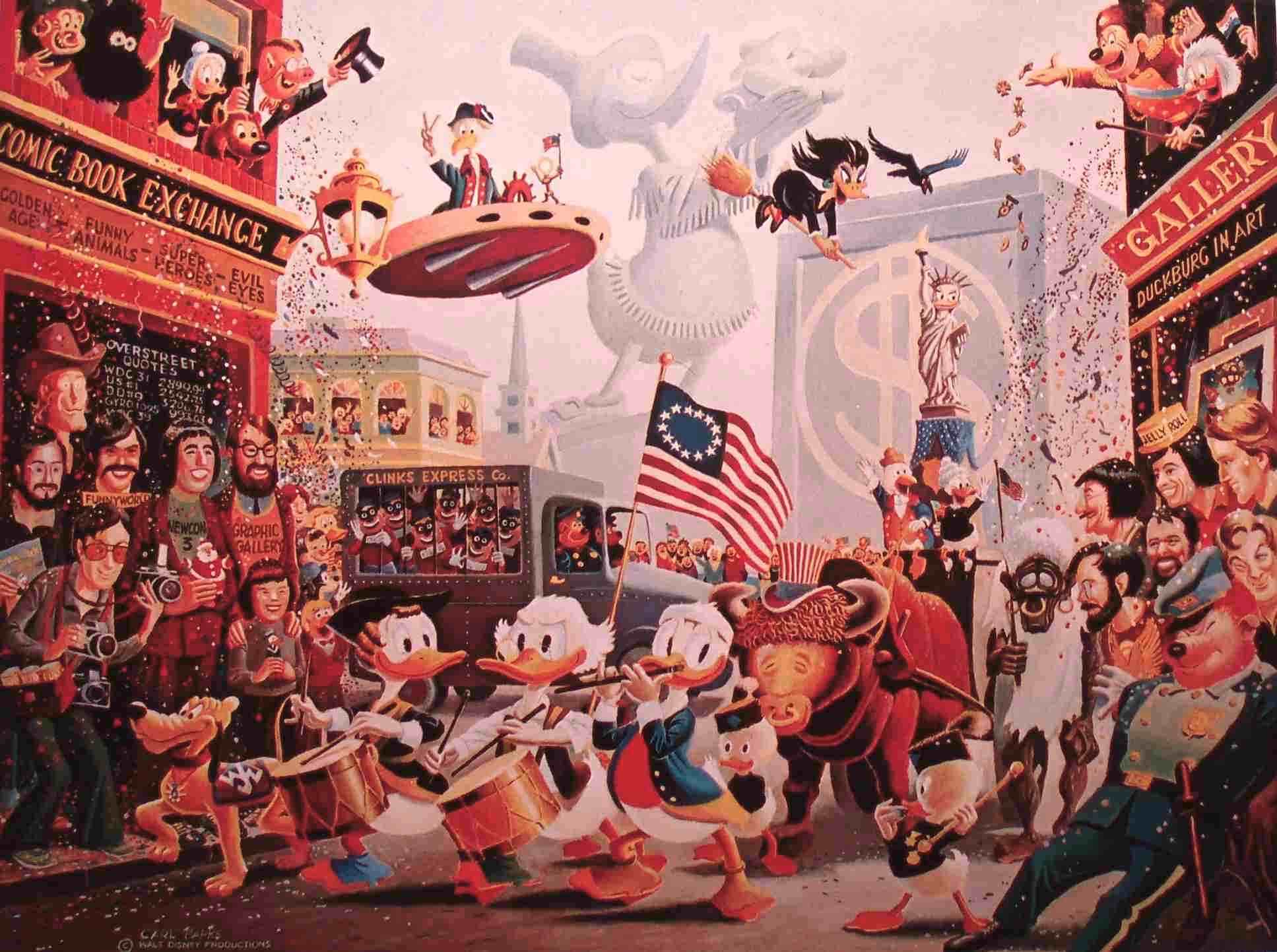PROJECTS
.

Cochran and Hamilton at the Boston
Newcon in 1976 auctioning one of Barks' paintings
From 1973
on Cochran and Hamilton functioned as Barks'
sales managers of his duck and non-duck paintings.
They visited a great many conventions
successfully promoting and selling his work.
Cochran reminisces: I met Bruce Hamilton at a
comics convention in the early 1970s, and our
mutual interests in the works of Carl Barks and
in collecting original comic art led to us
becoming good friends.
As time
went by Cochran became the driving force behind
the auctioning of Barks' paintings and he sold
many at increasingly better prices while
crisscrossing the country, and he also managed to
place promotional articles and graphic
advertisements in gallery magazines. Also, Barks
furnished Cochran with lengthy lists of potential
purchasers, whom he could contact.
Cochran was tireless in selling Barks' paintings.
In one of his first reports to Barks he wrote: ...
Green Persia and Secret Safe
sold instantly, and if I had had ten more, I
could have sold them all! The message is loud and
clear. Your paintings are in great demand. They
should be priced at $500 to $1000 depending on your
estimation of them.
Barks was, of course, very pleased with the
rising demand, but in several letters from then
on he would express his vexation that he was
unable to keep up with the increasing demand.
Cochran on the other hand became so 'embarrassed'
about his increasing percentage earnings that he
insisted on a lower payment for his work!!!
In 1980
Hamilton and Cochran created two joint companies
dedicated to a greater recognition of Barks' work.
The first company's name was Another Rainbow
Publishing (commonly known as AR). The
somewhat enigmatic name derives from Scrooge
McDuck's saying that 'there will always be
another rainbow'. The other company's name
was Gladstone Publishing, where the name
was taken from Barks' primary character Gladstone
Gander. It was a subsidiary company to AR and
soon became the major (and for most of the time
the only) publisher of Disney comic books in the
USA. The books contained duck stories by
especially Barks, but several new artists such as
Keno Don Rosa and William van Horn were
represented as well. A novelty was that AR had
obtained the rights to also publish the artists'
names in connection with their stories, thus
breaking a steadfast rule in Disney's publishing
policy.
Cochran reminisces: We formed a partnership
known as Another Rainbow Publishing and Gladstone
Publishing in 1980 to explore the
possibilities of publishing the works of Carl
Barks, including his oil paintings and his comic
book stories. Bruce was an unforgettable
character, full of idiosyncrasies which often
made him difficult to deal with, but his natural
intelligence and life-long love of learning made
people respect him. He and I enjoyed many cross-country
motor trips together where he would talk and I
would listen. He was a rare and strange duck, and
I will miss him.
The first
publishing related to Barks was an imposing art
book with the equally imposing title The
Fine Art of Walt Disney´s Donald Duck by Carl
Barks. The book lavishly reproduced all
of the 122 duck paintings he had officially
finished by that time. To obtain the splendid
results, no fewer than 50 photographers from the
USA and Canada were asked to photograph the
paintings. The photos needed extra attention to
secure the best possible reproduction as the
normal printing process only consists of 4
colours. They succeeded and Barks was satisfied.
The book had a run of 1,875 copies - all signed
by Barks personally!
Shortly after AR began producing series of fine
art lithographs of many of the paintings in
strictly limited editions, and they ended up
producing a small series of elaborate serigraphs
in the beginning of the 1990s. All products were
signed by Barks.
In 1983 AR
aired an even more ambitious project. Hamilton
and Cochran had obtained the rights from The
Walt Disney Company to publish all of Barks'
stories and front covers in a monumental opus of
unequalled dimensions! It was called The
Carl Barks Library (CBL) and
consisted of 30 voluminous luxury books in 10
boxed, slipcase sets (i.e. 3 books to a set). The prestigious series of
books was published over a number of years (from
July 1984 to August 1990).
The books also contained numerous
new contributions from both Barks and other
artists. Furthermore the books were filled with
many special features such as articles,
interviews, sketches, storyboards, and
modelsheets. It took a good 6 years to finish the
giant undertaking but it was certainly worth
waiting for as the comic book stories are
perfectly reproduced - mostly in black and white.
They also incorporated vast amounts of Disney
material unknown to the public until then.
From 1992 to 1998 AR republished
all of Barks' Disney stories, but this time in
141 handy albums. The name was The Carl
Barks Library in Color (CBLiC), and it
came close to the CBL apart from a few novelties;
all the stories were in full colour, the stories
came in the original chronological order, the
albums contained special trading cards, and new
articles and other material were added.
AR's last Barks related
project was the launching of yet another
ambitious project namely the manufacture of
limited editions of 10 figurines made in fine
porcelain. Barks based the motifs on recognizable
subjects and events from his stories, and he made
all the necessary and detailed sketches for the
figurine manufacturer to follow (see more HERE).
As the figurines were handmade by the finest
craftsmen using the finest materials they had to
be heavily priced, and this fact led to less
sales than expected, although the interest was
very much present. This, in turn, led to one of
the saddest events in Barks' professional career,
as many of them had to be destroyed in 2001 (see
more HERE)...
|


